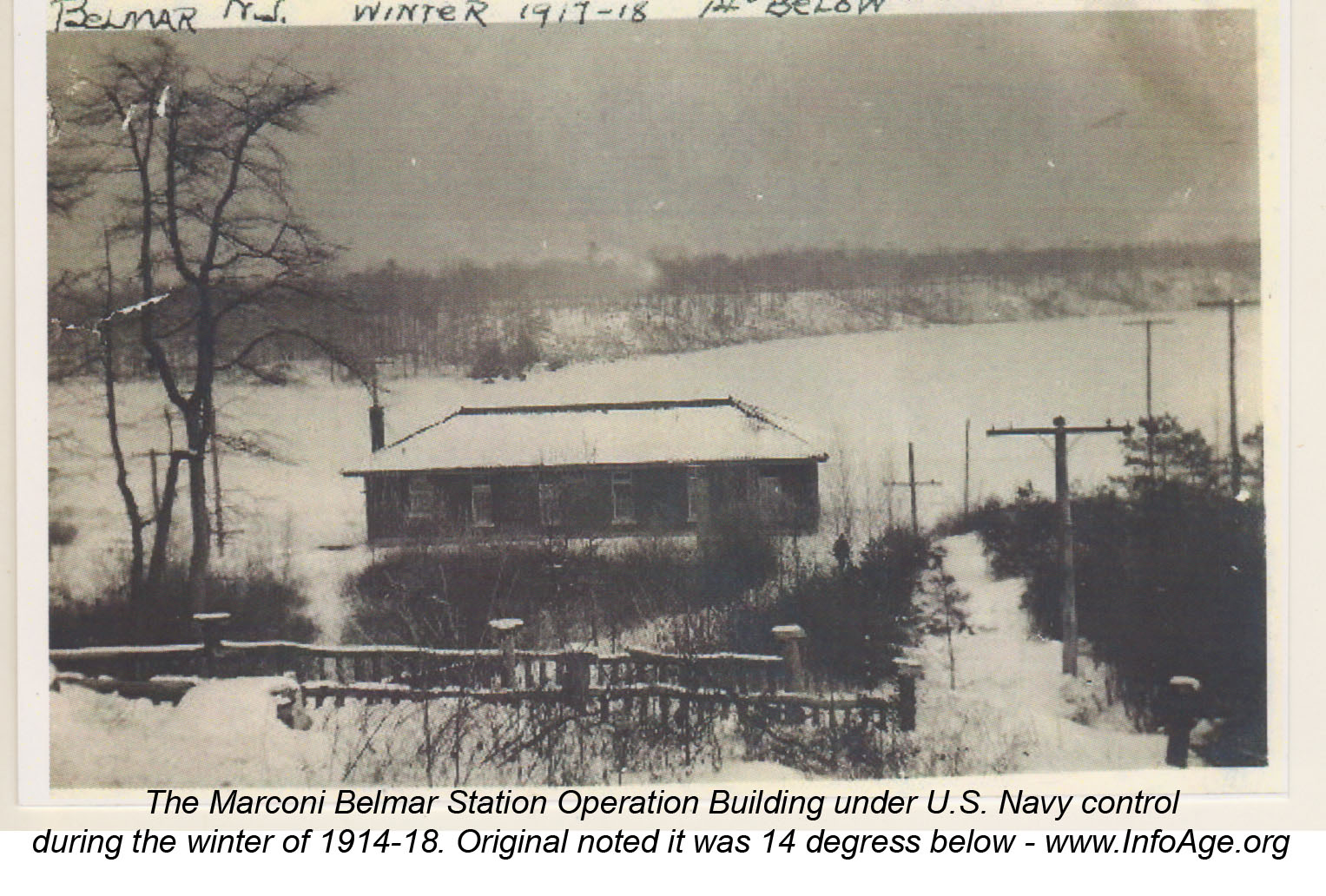The History of InfoAge Science & History Museums
WWI at The Belmar High Powered Wireless StationWWI at The Belmar High Powered Wireless Station
This overview post tells the WWI history of Camp Evans, the Marconi Belmar station. It was a significant communications control point and research site during the United States involvement in WWI. In fact, it was the central hub of wireless communications between Washington and the American Forces in Europe. It was the control facility of the Belmar-New Brunswick link to Europe. The major trans-Atlantic wireless stations, for example, the German Stations at Tuckerton, NJ, and Sayville, NY as well as the Chatham, MA station on Cape Cod were connected by landlines to the Belmar Station. The site was an early electronic countermeasure and suspected enemy message collection for decoding. The site hosted significant persons during this period who contributed to the advance of radio technology. The site also dispatched some of the most important diplomatic radiograms for President Wilson during the war.

An excellent resource: RADIO REMINISCENCES: A HALF CENTURY by A. Hoyt Taylor
Roy Wagant’s Static Elimination Innovation
How wireless Shortened WWI
A Century Ago Belmar and Wall enter the Great War. By Fred Carl
Presidential executive orders, they are in the news now, but they are not new phenomena. A century ago on April 7, 1917, President Wilson issued an executive order which impacted the quiet Jersey Shore. The United States had joined the World War. With a stroke of a pen, every wireless station in American was seized by the government, including the Belmar Marconi station in Wall Township. By the end of the War, the use of the wireless would shorten the horrible war, saving lives on both sides. A wireless innovation made in Wall would enable Allied Signal Corps soldiers and spies to listen to German wireless messages without them knowing. This same innovation would enable the birth of radio communications to the millions of eager listeners. Great leaders and innovators in wireless, whose names once splashed in the headlines, worked in Wall during the Great War. The innovation would also make the giant Belmar station obsolete, leading to its closure.
Before the Presidential order was signed, the Great War was raging in Europe. Few local residents knew the War had already come here. Fears on both sides pointed to the south bank of the Shark River. As early as 1914 a New York Times story echoed German fears in a headline that Germany “Fears Belmar Station”. Germany was worried that the British were using the giant Belmar station to send coded messages to their warships in the Atlantic. The Germans demanded ‘censors’ to monitor the station messages. American citizens were worried German saboteurs and terrorists would destroy critical American assets.
When the order was issued, the U.S. Navy sent staff to take over the trans-Atlantic high powered wireless operations in Wall. The takeover also included the giant remote wireless transmitter 40 miles away in Franklin Township, just north of New Brunswick and the Marconi manufacturing plant in Roselle Park. The order also authorized the takeover of the German wireless stations in Tuckerton, NJ and Sayville, Long Island. Their staff was arrested and sent to POW camps. A few months later a company of 100 U.S. Marines was stationed in Wall to protect the station from German saboteurs. The Navy ordered their top wireless expert, A. Hoyt Taylor, to assemble a team and make Wall the central hub of wireless communications between the War Department in Washington and American forces fighting in Europe. Some of the most important messages of the Great War were dispatched to and from Wall.
The Navy had wireless experts working in Wall to prevent the Germans from interfering with wireless communications. Harold Beverage would set up a giant ‘Barrage antenna’ in Wall. Once proven it was effective, similar ones were built in Europe.
A major problem in old technology wireless was static. We now know the source of static is sun-spots. When sun-spots would flare up the wireless picked up so much static that communication was ‘knocked out’ for up to eight hours at a time. Roy Weagant created a special test system in Wall that not only eliminated most of the static, it enabled low power battlefield wireless receiver sets to pick up transmissions once undetectable. The new technology wireless sets were manufactured in secret in the Marconi Plant in Roselle Park. Once the units reached Allied troops in Europe they could capture German messages without the enemy suspecting. This gave the Allies a major spying advantage.
As the Great War was going badly for Germany its population began to demand an end to the carnage. Germany used its giant wireless station near Berlin to send messages to the Belmar station in October 1918 indicating the desire for an Armistice. The easy communications speeded an end to the war. After the war, the use of the wireless station and its specially designed 200KW transmitter by Ernst Alexanderson was credited with shorting the war by months. This saved thousands of lives on both sides.
With the war over the amazing innovation of static elimination was disclosed to the public. It was hailed as the most important advance of the decade. The press printed stories of how the Allies could listen to German internal communications, “Almost everything the Germans sent out bearing on the question of peace was received“. This was a major advantage for the Allies in political negotiations.
The elimination of static would enable the ‘dots and dashes’ of wireless to be replaced by the human voice. Any person could now talk on the wireless. If you could talk on the wireless then you could sing on the wireless. Companies would begin singing commercials to sell their products. Wireless would become a radio and the world of commutations would explode into a worldwide enterprise. New professions would appear such as radio announcer, radio technician, sound effects man, and the most exciting the radio star was born.
The innovation would also make the Belmar Station obsolete. The six 400 foot tall towers needed to capture wireless waves from Europe were not needed with the new technology. As one NY paper headline read the day the innovation was disclosed, “Wireless Without Towers, Invented Here, First Used by U.S. Navy, then by Allies”. By 1926 the towers in Wall were all dismantled and wireless development left Wall and Belmar seemingly forever.
A new war in Europe, just about twenty years later, would bring wireless, radio, and a new technology called radar back to Wall Township eclipsing the WWI history of a century ago.
Posted April 6, 2017, in honor of the 100th Anniversary of The Great War
We Need Your Help! Volunteer with Us.
Join our mission to preserve historic Camp Evans and teach the public about science and history.
Sign up to join our team of volunteers and start on your own mission today.
InfoAge Science & History Museums
2201 Marconi Road
Wall, NJ 07719
Tel: 732-280-3000
info@infoage.org
webmaster@infoage.org
